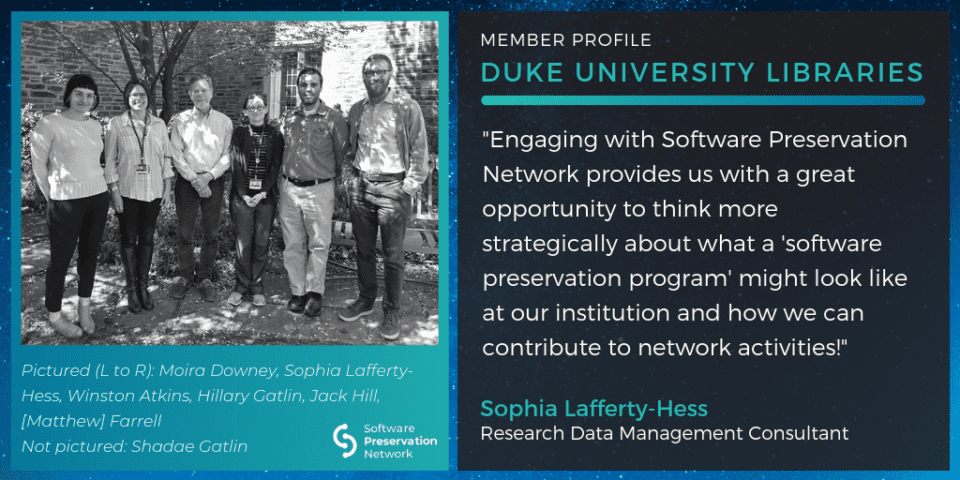Tell us about the software preservation program at your organization.
Currently at Duke University, we preserve a variety of digital objects within our repository and preservation programs including research data, code and script files, born digital materials, records generated by our institution, etc. In some of these collections we may also receive software programs; however, as an institution, we have not formally developed a “software preservation program.”
We have a Digital Preservation Working Group that has been thinking holistically about our preservation procedures and working with our Governance group to enhance our overall preservation strategies. Engaging with Software Preservation Network provides us with a great opportunity to think more strategically about what a “software preservation program” might look like at our institution and how we can contribute to network activities!

What has your organization accomplished recently that you’re proud of – big or small?
Our Digital Preservation Working Group has recently completed an assessment of our current practices against the NDSA Levels of Preservation in an effort to enhance our preservation procedures for all types of digital objects. This exercise enabled us to determine our highest priorities to advocate for resources and to develop as a group.
For our research data curation program, we are also proud to be a contributing institution to the Data Curation Network, which has enabled us to work with our colleagues to harness the knowledge and expertise of the collective to more effectively curate data (and code) for access, use, and long-term preservation.
We are also proud to have joined SPN!
Tell us about a challenge that your organization is facing in its software preservation work or that the field is facing as a whole?
There are many digital objects that we preserve that rely upon certain software programs; however, individual institutions cannot reasonably maintain copies of all these programs – and this is not to mention the legal complexity that surrounds preserving and providing access to this software, which is a huge challenge in this space.
Locally – determining where a software program would “fit” within existing programmatic areas is also difficult as it cuts across various departments even as it supports our overall strategic goals.
Name a software title or library that is particularly significant for one or more of your user constituencies, and tell us why that title or library is particularly significant.
Within our Research Data Repository one of our depositors often submits Matlab scripts for reproducing the figures found in his associated article. Ensuring future reproducibility will rely upon stable access to this proprietary software; however, we currently have no local approach in place to meet this need. We can preserve the code but we can’t provide any assurances that researchers will be able to use the code in 5 or 10 years from now.
Why is collective action the best approach to software preservation?
Because we can’t do it alone! Resources at individual institutions are limited but expertise abounds across our field.
Even locally, working collectively on any preservation question helps to build understanding across program areas and types of digital objects. We have witnessed this first hand within our Digital Preservation Working Group which brings together various stakeholders engaged in preservation from University Archives, to our Data Repository and Curation Program, to IT support staff – working on problems together is just more efficient for building capacity.